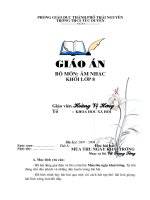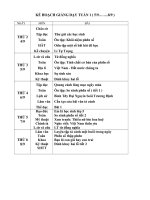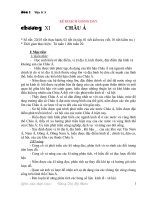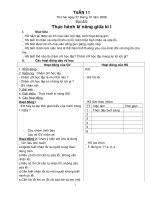Bài giảng lớp y sỹ wound emergency
Bạn đang xem bản rút gọn của tài liệu. Xem và tải ngay bản đầy đủ của tài liệu tại đây (1.31 MB, 52 trang )
Classification and management of
wound, principle of wound healing,
haemorrhage and bleeding control
1
GYÖRGYI SZABÓ
ASSISTANT PROFESSOR
DEPARTMENT OF SURGICAL
RESEARCH AND TECHNIQUES
Basic Surgical Techniques, Faculty of Medicine, 3rd year
2021/13 Academic Year, Second Semester
2
WOUND
What is a wound?
3
It is a circumscribed injury which is caused by an
external force and it can involve any tissue or organ.
surgical, traumatic
It can be mild, severe, or even lethal.
Simple wound
Compound wound
Acute
Chronic
Parts of the wound
4
Wound edge
Wound
corner
Surface of
the wound
Base of the wound
Cross section of a simple wound
Wound edge
Wound
cavity
Surface of
the wound
Base of the wound
Skin surface
Subcutaneus tissue
Superficial fascia
Muscle layer
The ABCDE in the injured assessment
5
The mnemonic ABCDE is used to remember the
order of assessment with the purpose to treat
first that kills first.
A: Airway and C-spine stabilization
B: Breathing
C: Circulation
D: Disability
E: Environment and Exposure
Wound management - anamnesis
6
When and where was the wound occured?
Alcohol and drug consumption
What did caused the wound?
The circumstances of the injury
Other diseases eg. diabetes mellitus, tumour,
atherosclesosis, allergy
The state of patient’s vaccination against Tetanus
Prevention of rabies
The applied first-aid
Classification of the accidental wounds
1. Based on the origine
7
Mechanical wounds
8
1.) Abraded wound
(v. abrasum)
2.) Punctured wound
(v. punctum)
Superficial part of the
Sharp-pointed object
Seems negligible
epidermal layer
Good wound healing
BUT
Anaerobic infection
Injury of big vessels and
nerves
Mechanical wounds
9
3.) Incised wound
(v. scissum)
4.) Cut wound (v. caesum)
Sharp object
Sharp object + blunt
Best healing
additional force
Edges - uneven
Mechanical wounds
10
6.) Torn wound
(v. lacerum)
5.) Crush wound
(v. contusum)
Blunt force
Pressure injury
Edges – uneven and torn
Bleeding
Great tearing or pulling
Incomplete amputation
(v. lacerocontusum)
Mechanical wound
11
7.) Shot wound (v. scolperatium)
Close - burn injury
Foreign materials
aperture
output
slot tunel
unijured tissue
necrobiotic zone
necrotic zone
foreign bodies
Mechanical wounds
12
8.) Bite wound (v. morsum)
Ragged wound
Crushed tissue
Torn
Infection
Bone fracture
Prevention of rabies
Tetanus profilaxis
The direction of the flap
13
Distal
Proximal
The wound healing is good
Chemical wounds
14
1.) Acid
in small concentration – irritate
in large concentration –
coagulation necrosis
2.) Base
colliquative necrosis
Wounds caused by radiation
15
Symptoms and severity
depend on:
Amount of radiation
Length of exposure
Body part that was exposed
Symptoms may occur
immediately, after a few days,
or even as long as months.
What part of the body is most
sensitive during radiation
sickness?
bone marrow
gastrointestinal tract
Wounds caused by thermal forces
16
1.) Burning
Metabolic change! - toxemia
a – normal skin
1 - 1st degree – superficial injury
(epidermis)
2 – 2nd degree –partial or deep partial
thickness (epidermis+superficial or
deep dermis)
3 – 3rd degree – full thickness
(epidermis + entire dermis)
4 – 4th degree – (skin + subcutaneous
tissue + muscle and bone)
Treatment:
Cooling – cold water and clean covering
2.) Freezing
mild, moderate, severe (redness,
bullas, necrosis)
rewarm – not only the frozen area
but the whole body
Special wounds
17
Exotic, poisonous animals
Toxins, venom -
toxicologist
Skin necrosis
Classification of the wounds
2. According to the bacterial contamination
18
Clean wound
Clean-contaminated wound
Contaminated wound
Heavily contaminated wound
Classification of the wounds
2. Depending on the depth of injury
19
Superficial
Partial thickness
Full thickness
Deep wound
+ bone, opened cavities, organs…etc.
source: />
Wound management - history
20
Ancient Egypt – lint (fibrous base-wound site closure), animal grease (barrier)
and honey (antibiotic)
„closing the wound preserved the soul”
Greeks – acute wound= „fresh” wound; chronic wound = „non-healing” wound
maintaining wound-site moisture
Ambroise Paré – hot oil ↔ oil of roses and turpentine, ligature of arteries
instead of cauterization
Lister pretreated surgical gauze – Robert Wood Johnson →1870s; gauze and
wound dressings treated with iodide
Applied wound management colour continuum
21
black
black-yellow
yellow
yellow-red
source: Applied wound management supplement – www.wounds-uk.com
red
red-pink
pink
Applied wound management
infection continuum
22
the quantity and diversity of microbes
contamination
sterility
critical colonisation
colonisation
source: Applied wound management supplement – www.wounds-uk.com
infection
Applied wound management
exudate continuum
23
Viscosity
volume
high - 5
medium - 3 low - 1
high - 5
medium -3
low - 1
source: Applied wound management supplement – www.wounds-uk.com
The wound managemanet
24
Temporary wound management (first aid)
clean, hemostasis, covering
Final primary wound management
clean, anaesthesis, excision, sutures
ALWAYS: thoracic cavity, abdominal wall or dura mater injury
NEVER: war injury, inflammation, contamination, foreign
body, special jobs,
bite, shot, deep punctured wound
Primary delayed suture (3-8 days)
clean, wash – saline, cover
excision of wound edges, sutures
The wound managemanet
25
Early secondary wound closure (2 weeks)
after inflammation, necrosis – proliferation
anesthesia, refresh wound edges, suturing and draining
Late secondary wound closure (4-6 weeks)
anesthesis, scar excision, suturing, draining
greater defect – plastic surgery









